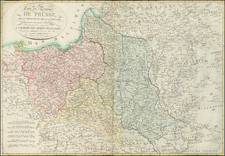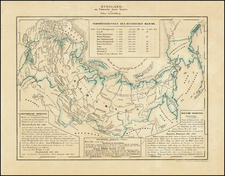Nice example of Coronelli's two sheet map of Russia, extending from the Baltic and the Black Sea in the west to Gran Tartaria in the east.
Coronelli's map of Russia is one of the most detailed and elaborate maps of the 17th Century, providing tremendous detail in the fine exacting style which characterizes Coronelli's maps. The map is further embellished by two elaborate decorative cartouches and many vignettes of indigenous peoples, villages, hunting, animals, etc., including depictions of the nomadic tribes extending north from the Caspian Sea to east of the Gulf of Nova Zembla. The Cosack warriors are seen in the southeast part of the map.
Vincenzo Maria Coronelli (1650-1718) was one of the most influential Italian mapmakers and was known especially for his globes and atlases. The son of a tailor, Vincenzo was apprenticed to a xylographer (a wood block engraver) at a young age. At fifteen he became a novice in a Franciscan monastery. At sixteen he published his first book, the first of 140 publications he would write in his lifetime. The order recognized his intellectual ability and saw him educated in Venice and Rome. He earned a doctorate in theology, but also studied astronomy. By the late 1670s, he was working on geography and was commissioned to create a set of globes for the Duke of Parma. These globes were five feet in diameter. The Parma globes led to Coronelli being named theologian to the Duke and receiving a bigger commission, this one from Louis XIV of France. Coronelli moved to Paris for two years to construct the King’s huge globes, which are 12.5 feet in diameter and weigh 2 tons.
The globes for the French King led to a craze for Coronelli’s work and he traveled Europe making globes for the ultra-elite. By 1705, he had returned to Venice. There, he founded the first geographical society, the Accademia Cosmografica degli Argonauti and was named Cosmographer of the Republic of Venice. He died in 1718.

![Moscovia Parte Orientale . . . [with] Parte Occidentale . . . By Vincenzo Maria Coronelli](https://storage.googleapis.com/raremaps/img/small/26615.jpg)








![[ Transylvania ] Karte von Siebenberg nach den besten Hulfsmitteln verfast](https://storage.googleapis.com/raremaps/img/small/103015.jpg)
![[Spitzbergen & Wiches Lande]](https://storage.googleapis.com/raremaps/img/small/61990.jpg)
![Danubii Fluminis (hic ab urbe Belgrado, per Mare Nigrum usq[ue] Constantinopolim defluentis exhibiti) pars infima](https://storage.googleapis.com/raremaps/img/small/91026.jpg)
![[ Eastern Poland ] Der Koniglichen Republik Polen Woiwodschaften Podlachien mit dem obern Theileder Woiwodschafter Lublin, oder Klein Polens…](https://storage.googleapis.com/raremaps/img/small/102985.jpg)

